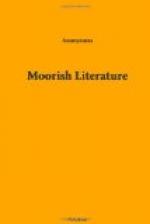[6] R. Basset. Les Aventures Merveilleuses de Tunis et Dais. Rome, 1891, en 8vo. L’expedition du Chateau d’or, et la combat d’Ali et du dragon. Rome, 1893, en 8vo. M’lle Florence Groff. Les sept dormants, La ville de Tram, et l’excursion contre la Makke, Alger, 1891, en 8vo.
It is thus that a literature in Spain sadly ends which, during seven centuries, had counted historians and poets, philologists, philosophers and savants, and which the Christian literature replacing it can possibly equal in some points, but never surpass.[7]
[Illustration (Signature Facsimile): Rene Basset]
[7] M. Basset’s “Special Introduction” was written in French; the English translation was made by Robert Arnot.
PREFACE
The Moorish ballads which appear in this volume are selected from a unique department of European literature. They are found in the Spanish language, but their character is oriental; their inspiration comes from the Mahometan conquerors of northern Africa, and while they exhibit a blending of Spanish earnestness and chivalry with the wild and dashing spirit of the Arab, they present a type of literature which is quite unparalleled in the Latin and Teutonic countries of the Mediterranean basin.
Spain is especially rich in ballad literature, infinitely richer than any other civilized nation. These ballads take various forms. By Cervantes and his countrymen they are styled romances, and the romance generally consists in a poem which describes the character, sufferings, or exploits of a single individual. The language is simple; the versification, often artless though melodious, is seldom elaborated into complexity of rhyme. But the heroic Moor is set before us in the most vivid colors. The hues and material of his cloak, his housings, his caftan, and his plumes are given, and quite a vocabulary is exhausted in depicting the color, sex, and breed of his war-horse. His weapons, lance, scimitar, and corslet of steel are dwelt upon with enthusiasm. He is as brave as Mars, and as comely as Adonis. Sometimes he dashes into a bull-ring and slays wild creatures in the sight of fair ladies and envious men. He throws his lance of cane, which is filled with sand, so high that it vanishes in the clouds. He is ready to strike down, in his own house, the Christian who has taken from him and wedded the lady of his choice. He is almost always in love with some lady who is unkind and cold, and for her he wanders at times in dark array, expressing his sombre mood in the device and motto which he paints upon his shield. Some of the ballads picture love more fortunate in the most charming manner, and the dark tortures of jealousy are powerfully described in others. The devotion of the Moor to his lady is scarcely caricatured in the mocking language of Cervantes, and is not exceeded by anything to be found in the history of French chivalry. But the god of these ballads is Allah, and they sometimes reveal a trace of ferocity which seems to be derived from religious fanaticism. Nor can the reader fail to be struck by the profound pathos which many of them express so well. The dirges are supremely beautiful, their language simple and direct, but perfect in descriptive touches and in the cadence of the reiterated burden.




